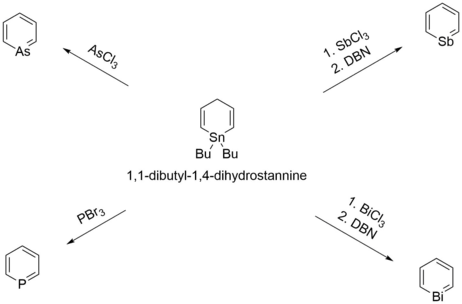Stibinin
Stibinin, also known as stibabenzene,[1] is an organic chemical compound. Stibinin has the chemical formula C5H5Sb (MW: 186.86 g/mol). The molecule, stibinin, is a derivative of benzene, with one of the carbon atoms in the 6-membered ring replaced by an antimony (Sb) atom. Stibinin is a molecule that is considered to be an organoantimony compound due to it containing carbon, hydrogen, and antimony atoms.
 Stibinin: The white balls represent hydrogens, the light gray balls represent carbons, and the dark gray ball represents Antimony. | |
| Names | |
|---|---|
| Other names
Antimonin; Stibinine; Stibabenzene | |
| Identifiers | |
3D model (JSmol) |
|
| ChemSpider | |
PubChem CID |
|
CompTox Dashboard (EPA) |
|
| |
| |
| Properties | |
| C5H5Sb | |
| Molar mass | 186.855 g·mol−1 |
Except where otherwise noted, data are given for materials in their standard state (at 25 °C [77 °F], 100 kPa). | |
| Infobox references | |
Laboratory synthesis
The synthesis of stibinin can be accomplished in a three step process. The final product can be isolated, even though the molecule is highly labile. The first step of this synthesis involves the treatment of penta-1,4-diyne with dibutylstannane as shown in the figure below.[2]

The second step of the synthesis involves reacting the product of the first step, 1,1-dibutyl-1,4-dihydrostannine, with antimony trichloride, to yield 1-chloro-1-stibacyclohexa-2,5-diene.[1]

The final step of the synthesis of stibinin involves treating 1-chloro-1-stibacyclohexa-2,5-diene with a base, such as 1,5-Diazabicyclo[4.3.0]non-5-ene (DBN), to yield the final product of stibinin.

Similar compounds
It is noted that other benzene derivatives with one carbon replaced with a group 15 element can be synthesized via a similar synthetic pathway to that which stibinin is synthesized. The reaction of 1,1-dibutyl-1,4-dihydrostannine with arsenic trichloride, phosphorus tribromide, or bismuth trichloride can yield arsabenzene, phosphabenzene, or 1-chloro-1-bismacyclohexa-2,5-diene respectively. Treatment of 1-chloro-1-bismacyclohexa-2,5-diene with a base, such as DBN, can yield the product bismabenzene.[3]

References
- Ashe, Arthur J. (December 1971). "Stibabenzene". Journal of the American Chemical Society. 93 (24): 6690–6691. doi:10.1021/ja00753a069. ISSN 0002-7863.
- Ashe, Arthur J.; Fang, Xiangdong; Fang, Xinggao; Kampf, Jeff W. (December 2001). "Synthesis of 1,2-Dihydro-1,2-azaborines and Their Conversion to Tricarbonyl Chromium and Molybdenum Complexes". Organometallics. 20 (25): 5413–5418. doi:10.1021/om0106635. ISSN 0276-7333.
- Ashe, Arthur J. (February 2016). "The Route to Phosphabenzene and Beyond" (PDF). European Journal of Inorganic Chemistry. 2016 (5): 572–574. doi:10.1002/ejic.201600007. ISSN 1434-1948.